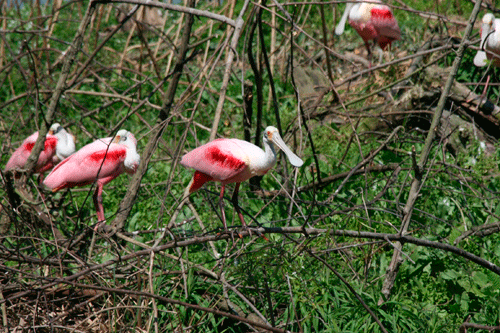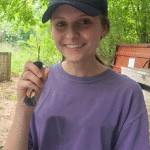
Roseate Spoonbills roosting at the Smith Oaks Rookery in High Island, Texas. Photo by Sarah Belles.
Although Roseate Spoonbills are not an unusual sight in coastal habitats, I still get excited when I see these colorful, somewhat bizarre looking birds. The spoonbill’s pink coloration looks pretty out of place compared to its surroundings, but makes sense considering its diet, which includes lots of crustaceans. Like flamingos that sport similar pink plumages, spoonbills can attribute their vibrant color largely to what they eat.
Some other characteristics you can look for to identify adult Roseate Spoonbills besides their flashy feathers include a light greenish colored bald head, red eyes, and visible ear openings. Juveniles, however, may look a little different since they have completely feathered heads and are much paler in color compared to adults. A Roseate Spoonbill will typically grow into its adult plumage by about three years of age.
A trademark trait of Roseate Spoonbills is their odd bill shape that resembles a large spoon, hence the name “Spoonbill.” Interestingly, when spoonbill chicks hatch, they don’t yet have the spoon-like bill shape that is characteristic of adults. It takes about a week or two before the bill will begin to flatten into the recognizable shape. To feed, spoonbills wade in shallow water, swishing their bill side to side to feel for things like shrimp, fish, and insects. When a spoonbill locates prey, it will quickly snap its bill shut and usually just swallow its meal whole.
You can find Roseate Spoonbills in freshwater or marine areas in places such as wetlands, bays, and swamps. When not feeding, they like to roost in shrubs and trees. Spoonbills might gather in small groups, or they often can be found congregating in relatively large flocks, especially during the breeding season. They can commonly be seen in mixed groups made up of ibis, herons, and egrets as well.
To get a female’s attention during the breeding season, a male will head bob and shake sticks for her. If the female accepts, the pair might grab each other’s bills or stretch their wings up to solidify the pairing. The male will bring the female plenty of sticks and nesting material while she does most of the nest building. Roseate Spoonbills can lay as many as five eggs for the breeding season but will most likely just lay two or three. After hatching, the chicks are ready to leave the nest in about five or six weeks and in another week or two will be able to fly.
Roseate Spoonbills are not of high conservation concern at the moment, but this hasn’t always been the case. Plume hunters in the late 1800s and early 1900s wiped out much of the United States’ spoonbill population, among other species. Feathers were in high demand for decoration on women’s hats, resulting in the harvesting of countless wading birds. Thanks to conservation efforts and a shift in fashion trends, Roseate Spoonbills have since made a comeback. Although Roseate Spoonbills are no longer hunted for their feathers, they can still be negatively affected by factors such as habitat loss and human disturbance.

Sarah Belles is a biology intern at the Gulf Coast Bird Observatory, a non-profit organization dedicated to saving the birds and their habitats along the entire Gulf Coast and beyond into their Central and South America wintering grounds
